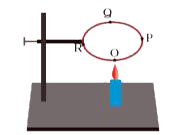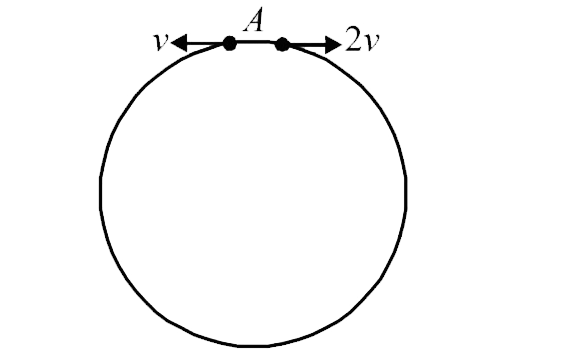Two identical metal balls A and B moving in opposite directions hit each other at point O as shown in the figure. Changes are most likely to appear in their

Shapes and speeds
Speeds and directions
Directions and volumes
Volumes and shapes
The correct Answer is:B
Due to collision of two identical metal balls, changes are most likely to appear in their speeds and directions.
Topper's Solved these Questions
- NSO MODEL TEST PAPER 02BOOK - SCIENCE OLYMPIAD FOUNDATION CHAPTER - NSO MODEL TEST PAPER 02EXERCISE - ACHIEVERS SECTION
2 Videos
- NSO MODEL TEST PAPER 01BOOK - SCIENCE OLYMPIAD FOUNDATION CHAPTER - NSO MODEL TEST PAPER 01EXERCISE - ACHIEVERS SECTION
2 Videos
- NSO QUESTION PAPER 2017-18 SET ABOOK - SCIENCE OLYMPIAD FOUNDATION CHAPTER - NSO QUESTION PAPER 2017-18 SET AEXERCISE - ACHIEVERS SECTION
1 Videos
Similar Questions
A circular metal loop is heated at point O as shown in figure.

In which direction would heat flow in the loop ?
View SolutionTwo ball bearings of mass m each moving in opposite directions with each speeds v collide head on with each other . Predict the outcome of the collision , assuming it to the perfectly elastic.
View Solution
Knowledge Check
Two identical bodies moving in opposite direction with same speed, collide with each other. If the collision is prefectly elastic then
Aafter the collision both comes to restBafter the collision first comes to rest and second moves in the opposite direction with same speed.Cafter collision they recoil with same speedDboth and 1 and 2When two identical balls are moving with equal speed in opposite direction, which of the following is true ? For the system of two bodies.
Amomentum is zero, kinetic energy is zeroBmomentum is not zero, kinetic energy is zeroCmomentum is zero, kinetic energy is not zeroDmomentum is not zero, kinetic energy is not zeroTwo identical balls moving in opposite directions in free space collide head on. How they will move after the impact, is decided by coefficient of restitution. For different coeffecients of restiution, few possible outcomes are shown in the following figures. Which of the above outcomes are physically possible for a collision?
 AOnly 1BOnly 2C1 and 2 but not 3D1 2 and 3 all
AOnly 1BOnly 2C1 and 2 but not 3D1 2 and 3 all
Two particles A and B are moving , as shown in the figure .

Their total angular momentum about the point O is
View SolutionTwo trains each 100 m long, moving in opposite directions, cross each other in 8 seconds. If one is moving twice as fast the other, then the speed of the faster train is 30 km/hr b. 45 km/hr c. 6 km/hr d. 75 km/hr
View SolutionTwo identical harmonic pulses travelling in opposite directions in a taut string approach each other. At the instant when they completely overlap, the total energy of the string will be
 .
.
View SolutionTwo particles A and B are moving as shown in the figure. Their total angular momentum about the point O is

View SolutionTwo small particles of equal masses stant moving in opposite direction from a point A in a burtizonetal circule orbic their tangention velocity are V and 2V , respectively as shown in the figure between collsions , the particals move with constant speed After making how many elastic collition , other the then that at A these two partical will again reach the point A ?

View Solution
